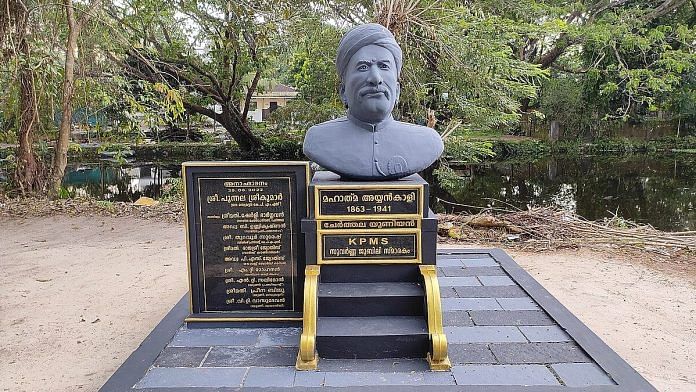New Delhi: In 1893, a man clad in a white shirt, mundu and a turban rode a bullock cart through the streets of Thiruvananthapuram. It was a normal sight in those days, to see smartly-dressed upper-caste people, especially Nair men and women. But the man riding the cart was neither, his name was Ayyankali, the now revered social leader and revolutionary.
He belonged to the Pulaya caste of untouchables in Kerala, who much like the other oppressed castes in Kerala were not allowed to wear clean clothes, ride a bullock cart, or use the road in the 19th century. Through this one act, 30-year-old Ayyankali had not just violated almost every social boundary in existence at the time, but had performatively claimed “public spaces” for the oppressed castes, writes Vivek V Narayan, an assistant professor at Ashoka University, in an article published in the Theatre Survey journal.
In Kerala, the caste system achieved the “highest degree of elaboration,” with over 500 divisions and subdivisions and conceptions of pollution, “which extended beyond untouchability to unapproachability,” write M Nisar and Meena Kandasamy in the book Ayyankali: A Dalit Leader of Organic Protest.
It was in this “madhouse of caste”—as Swami Vivekananda described Kerala—that Ayyankali was born on 28 August 1863. His villuvandi samaram (bullock cart protest), became one of the most important anti-caste struggles in the then Kingdom of Travancore in the late 19th century.
Also read: Caste pride is everywhere in Tamil Nadu’s Tirunelveli. Schools are the new scene of crime
Ayyankali the reformer
Ayyankali’s act of reclaiming and moving freely through spaces that were previously unavailable to the oppressed castes started a movement across Kerala. In 1898, he organised a pedestrian march leading to the Aralumoodu marketplace.
The upper castes, angered by the acts of perceived defiance, attacked Ayyankali and his companions as they reached Balaramapuram Chaliyar Street, in Thiruvananthapuram District. But the Dalits put up a strong fight. Recognising their strength, they began to start using public roads more often.
As a result, riots broke out across neighbouring regions such as Kazhakkoottam and Kaniyapuram. These riots were commonly referred to as the Chaliyar Riots, write Nisar and Kandasamy.
Ayyankali’s ‘walk for freedom’ spread across multiple regions in Travancore. The state eventually intervened and allowed the oppressed castes access to public roads by 1900.
Ayyankali’s fight didn’t end there. The next step was asking the government to admit Pulayas into public schools. He took students to schools and demanded their admittance. Finally, he opened his own school in Venganoor in 1904. But the opposition was swift and fierce.
The school was burnt down by the Nairs on the first day, according to a paper published by Muhammed Maheen, head of the department of history at the University of Calicut.
Also read: India’s Scheduled Caste list must be religion-neutral. Muslims, Christians are also Dalit
This led to what is considered to be the first strike by the Pulayas, writes Maheen, with Ayyankali declaring that without admittance of Pulaya students in schools, the lands of the upper caste would remain fallow and “grow weeds”.
This struggle ended in 1908 when the government issued a notification allowing Pulaya students to be admitted into schools. The government had to reissue the notifications in 1910 and 1914 due to resistance from the upper castes.
In 1915, the Perinad uprising, also known as the kallumala samaram began. Objectives of the larger fight included the use of public roads, wearing clean clothes, and access to education.
But the protest got its name from the stone and wood ornaments the women from the Pulaya community wore as an indicator of their caste status. They were only allowed to wear these and no other cloth in their upper bodies. As part of the meeting, Ayyankali asked them to cast these away and “become free”, writes P Renjini in her book, Historicizing Perinad Revolt.
One of the meetings was attacked by upper-caste communities, triggering violence that lasted several days and resulted in the torching of Dalit homes.
Also read: I once supported SC quota for ‘Dalit’ Muslims and Christians, but here’s why I don’t anymore
Ayyankali today
Ayyankali continued his fight for the rights of the oppressed castes in a variety of ways—from claiming public spaces to autonomy for the individual body and access to government education.
His methods, marches, strikes and disobedience, took place much before the arrival of Gandhi to the shores of India, who led the freedom movement using similar tactics.
Ayyankali left an indelible mark on the consciousness of the oppressed castes in Kerala. He has come to be called ‘Mahatma Ayyankali’. The old Victoria Jubilee Town Hall in Thiruvananthapuram was renamed by the Government of Kerala as the Mahatma Ayyankali Hall in 2019.
From 1911 for the next 25 years Ayyankali attended meetings of the Sree Moolam Popular Assembly (the legislature of Travancore). The government of Kerala in 2010 unveiled the Ayyankali Urban Employment Guarantee Scheme, the first of its kind in India, guaranteeing employment in urban areas.
Different prime ministers of India such as Indira Gandhi unveiled a statue of Ayyankali in 1980, and Narendra Modi has lauded Ayyankali’s efforts of social reform over the years – highlighting the political significance of his contributions today.
Mohiniyattam dancer Soumya Sukumaran’s latest performance is based on Ayyankali’s pursuit of education for Dalits. Titled, Panchami, Sukumaran who was barred from performing in a temple in Thrissur earlier this year due to her being non-Hindu debuted the dance on 24 August, Ayyankali day. It marked the first time the icon’s deeds were told through the dance form. Clearly, his life continues to inspire.
(Edited by Theres Sudeep)



